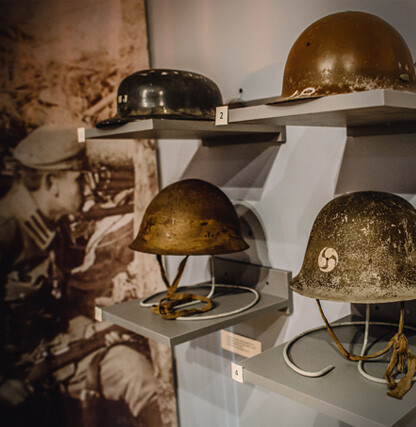HELMETS, CAPS AND UNIFORMS

in the history of the world’s armies
We invite you to visit the unique Gallery, located in the renovated interiors of a historic Krakow tenement house. We present here one of the largest collections of helmets and military caps in Poland. The collection was born out of passion for seemingly mundane objects, but which are carriers of history, technical thought, and human activity over several hundred years. The exhibition shows the variety and brings closer the history of military headgear by presenting how its appearance and function changed with the changes in the art of war. The exhibition will acquaint you with the development of headgear and uniforms all over the world, with a special emphasis on Europe as the standard bearer of military fashion.
For centuries, military headgear has played extremely important roles – from its representative function to its protective function. Sophisticated headgear was an indicator of high social status. The same was true of military caps and helmets, which were supposed to emphasize social rank and have a psychological effect due to their often unique character. For centuries, headgear has distinguished people serving in military formations, and the uniform has inspired respect and trust.
… read more
Historical background
collections
Since ancient times, military headgear has played an extremely important role – from its representative to its protective function. Wearing fancy headgear signified high status in society.

CAP – the most important item of uniform …read more
HELMET – combat security …read more
UNIFORM – military, as well as various props necessary in the life of every soldier …read more
AMAZING PLACE
GOŁĘBIA 5
history of the tenement house
The beginnings of the tenement house at Gołębia 5 date back to the end of the 13th century. It is confirmed by stone threads discovered during recent restoration works. These works revealed a number of changes that took place in the building over the centuries. In the renovated cellars one can see fragments of walls and beams from the thirteenth, fourteenth and fifteenth centuries, the fifteenth-century portal, vault and shutters from the fifteenth and sixteenth centuries, and eighteenth-century stone pillars and arcades.




